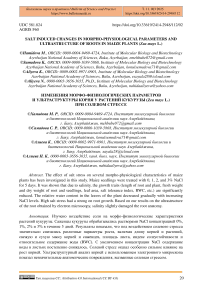Salt induced changes in morpho-physiological parameters and ultrastructure of roots in maize plants (Zea mays L.)
Автор: Hamidova M., Samadova K., Aliyeva K., Aliyeva N.
Журнал: Бюллетень науки и практики @bulletennauki
Рубрика: Естественные науки
Статья в выпуске: 3 т.11, 2025 года.
Бесплатный доступ
The effect of salt stress on several morpho-physiological characteristics of maize plants has been investigated in this study. Maize seedlings were treated with 0, 1, 2, and 3% NaCl for 5 days. It was shown that due to salinity, the growth traits (length of root and plant, fresh weight and dry weight of root and seedlings, leaf area, salt tolerance index, RWC, etc.) are significantly reduced. The relative water content in the leaves of the plant decreased gradually with increasing NaCl levels. High salt stress had a strong on root growth. Based on our results on the ultrastructure of the root obtained by electron microscopy, salinity slightly damaged the root anatomy.
Maize, salt stress, root, ultrastructure, phytotoxic effect
Короткий адрес: https://sciup.org/14132500
IDR: 14132500 | УДК: 581.824 | DOI: 10.33619/2414-2948/112/02
Текст научной статьи Salt induced changes in morpho-physiological parameters and ultrastructure of roots in maize plants (Zea mays L.)
Бюллетень науки и практики / Bulletin of Science and Practice
UDC 581.824
The plant growth is controlled by a multitude of physiological, biochemical, and molecular processes and photosynthesis is a key phenomenon, which contributes substantially to the plant growth and development [1]. Different growth- and development-related processes depend on the interplay of intracellular organelles. The chloroplast is the key organelle for photosynthesis, in which both light and dark reactions of photosynthesis take place. However, this organelle is highly sensitive to different stressful environments such as salinity, drought, extremes of temperature, varying light intensity and it plays an important role in the formation of stress responses [2].
Soil salinity is an environmental factor that limits crop productivity. Salinity restricts plant morpho-physiological processes due to osmotic disturbance and ionic stress [3].
Salt stress affects seed germination, growth, and development of plants by altering physiological and metabolic processes that eventually lead to a reduction in yield [4].
It was shown that salt stress could restrict photosynthesis by decreasing photosynthetic pigments [5].
Salinity reduces leaf area and photosynthetic rate and alters the light phase of photosynthesis by inducing osmotic stress [6]. The negative impact of salinity on plant growth and metabolisms has been attributed, principally, to enhanced Na+ ion uptake, which causes an excess of Na+ ions in plant tissues [7].
Plant responses to salinity have been discussed over some decades and substantial research has been focused on the alterations of the growth parameters (i.e. plant height, root length, leaf area, fresh and dry weight) [8].
In recent years, progress has been made in understanding the chemical signaling related to the response of roots to stress conditions (changes in ABA concentrations, ethylene, reactive oxygen species) [9].
There are many reports which show that salinity induces water deficit in many crop species such as maize, sunflower, potato, and soybean [10].
Salt stress causes an increase in reactive oxygen species (ROS) which thereby accelerate toxic reactions as lipid peroxidation, protein degradations, and nucleic acid mutations [11].
Maize ( Zea mays L.) is the third most important cereal crop after rice ( Oryza sativa L.) and wheat ( Triticum aestivum L.) and is grown under a wide spectrum of soil and climatic conditions. It is an important C 4 plant from the Poaceae family and is moderately sensitive to salt stress. A morphological feature of the plant caused by salinity stress is an expression of various physiological interactions as a response to salinity stress. Numerous studies showed the negative effect of salinity on plant growth, leaf area, length, and number as the increase of salt concentration [12].
Morphological deterioration of plant organs caused by salinity might be preceded by the damage of plant anatomy and ultrastructure. In the present study, we have examined the salt-induced changes in morpho-physiological parameters and the ultrastructure of root and chloroplasts in maize plants.
Materials and methods
Plant material, treatments, and growth conditions: Seedlings of the maize plant (Zea mays L., cv. Zagatala-420, C4 type NADP-malic enzyme) were cultivated in a pot and grown in the growth chamber with a 14 h photoperiod of day/night regime at 26/22 0C, light intensity - 600 µmol m -2 s-1, and relative humidity of about 70%. Salinity treatment was started after the second leaf blades of the plants were fully developed by supplying 50 ml of 0 (control), 1, 2 and, 3% NaCl stock solutions every day. Distilled water served as control. The soil was kept moist by the addition of respective stock salt solutions at regular intervals. Each treatment was replicated five times in which a pot was considered as one replicate. After salt treatment for 5 days, the plant samples were taken.
Growth parameters: Samples were taken after the exposure of the maize plant to salt stress, the length of seedlings and roots, fresh and dry weight were determined.
Seedling growth: The root and leaf lengths were measured by using a centimetres scale. The biomass of the seedlings was determined based on fresh weight.
Leaf area : The leaf area was determined following the formula of Carleton and Foote [13]: Leaf area (sm2) = max-leaf length x max-leaf width x 0.75 where 0.75 is a correction factor.
Relative water content (RWC): Was determined gravimetrically and calculated using the following formula:
RWC (%) = (FW-DW)/(TW-DW) x 100
where FW-fresh mass, DW-dry mass, TW-turgid mass.
Phytotoxicity of root: Phytotoxic effect of salt on the growth of roots of maize seedlings was determined after salt treatment for five days, applying the formula of Chou and Lin [14].
Phytotoxicity of root (%) = Root length in control-Root length in treatment ×100 Root length in control
Tolerance index: The tolerance of seedlings against tested concentrations of NaCl was estimated by Wilkinson tolerance index (WTI) [15]:
I t = (I me /I c ) × 100
where Ime- an increase in the root length caused by NaCl where Ic- an increase in the root length in control
Light (LM) and Transmission electron microscopy (TEM): Plant samples were taken and fixed in 0.1M phosphate buffer (pH - 7.4) containing 2.5% glutaraldehyde, 2% paraformaldehyde, 4% sucrose, and 0.1% picric acid. Samples were postfixed in 1% osmium tetraoxide solution within 2 h after being left in the same fixer for one day. Araldite-Epon blocks were made from materials using general methods [16].
The semi-thin (1-2 µm) sections from the blocks taken on an EM UC7 (Leica, Germany) ultra-microtome, stained with methylene blue, azure II, and mainly with a fixer or toluidine blue were observed under light microscope Primo Star (Zeiss, Germany) and images of required portions were shot with EOS D650 (Canon, China) digital camera [17].
Statistical analysis: The paper presents data of three experiments carried out in three replicates. Calculations, graphs, and their descriptions were performed using the applications Microsoft Office Word 7 and Excel 7 for Windows XP.
Results
It is clear from the obtained data that applying NaCl resulted in a significant reduction in root length as well as the fresh and dry weight of the root and leaf compared to the respective control plants. Based on our results, due to salinity, the growth traits (length of root and plant, fresh weight and dry weight of root and seedlings, leaf area, etc.) were significantly reduced. Figure 1 shows maize seedlings grown at various concentrations of salt (0, 1, 2, and 3% NaCl).
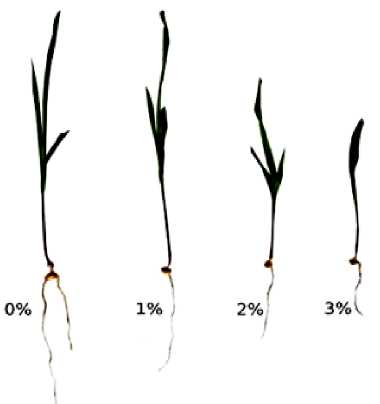
Figure 1. Maize seedlings grown under control (0% NaCl) and salinity stress (1, 2 and 3% NaCl) conditions
The response of roots to salinity stress indicates the salt tolerance potential of the plant. In the present study, the root length significantly decreased with increasing NaCl concentrations (Table). As shown in the table, a significant reduction in root growth of maize plants was observed at high concentrations (2 and 3%) of NaCl, which is attributed to the reduced water content due to declined water adsorption caused by induced osmotic and drought stresses. Dry matter of plants exposed to NaCl decreased significantly and the reduction was severe when treated with 3% NaCl (Table). Salinity affected the reduction in growth parameters such as root and plant length and dry mass. It was shown that the relative water content (RWC) in the leaves decreased gradually with increasing NaCl levels (Table).
Table
GROWTH CHARACTERISTICS OF MAIZE PLANTS UNDER SALT STRESS (seedling and root length, fresh mass and dry mass, leaf area, relative water content)
|
Treatments |
Fresh mass, g |
Dry mass, g |
Length, sm |
Leaf area, sm2 |
Relative water content, % |
|
Seedling |
|||||
|
0% NaCl |
3.84±0.13 |
0.36±0.04 |
18.80±1.52 |
114.84±1.7 |
81.2±14.91 |
|
1% NaCl |
2.56±0.12 |
0.27±0.05 |
18.53±1.44 |
76.24±1.5 |
76.7±14.22 |
|
2% NaCl |
2.51±0.12 |
0.23±0.03 |
15.20±1.33 |
62.16±3.1 |
68.9±13.48 |
|
3% NaCl |
2.10±0.11 |
0.20±0.02 |
12.70±1.12 |
54.90±2.4 |
61.4±12.21 |
|
Root |
|||||
|
0% NaCl |
1.27±0.10 |
0.14±0.03 |
6.74±2.45 |
||
|
1% NaCl |
0.94±0.32 |
0.08±0.02 |
6.68±1.36 |
||
|
2% NaCl |
0.71±0.38 |
0.06±0.02 |
5.74±1.40 |
||
|
3% NaCl |
0.57±0.27 |
0.05±0.01 |
4.21±1.33 |
||
The decrease was 5.54%, 15.14% and 24.39%, for 1%, 2% and 3% NaCl, respectively as compared to the control. Leaf water potential was also shown to decrease significantly under salt stress.
Salinity stress showed a strong phytotoxic effect on root growth at high salt concentrations (2 and 3% NaCl). The phytotoxicity of root increased as the concentration of salinity increased (Fig ure 2 ). The lowest root phytotoxicity of NaCl was observed in control and at 1% concentration of NaCl. The highest phytotoxicity of root (76.24%) was observed at 3% NaCl.
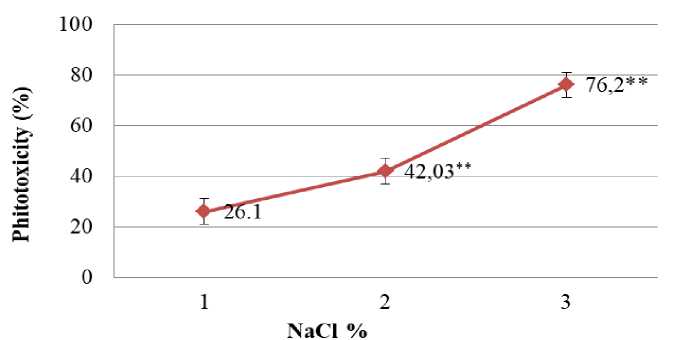
Figure 2. Effect of NaCl concentrations (mM) on phytotoxicity of roots in maize plant
Salt tolerance indexes (STI) were commonly higher in the lower salinity levels than in increased salinity levels. Salt tolerance index is a function of both germination rate and total dry weight; therefore, it is a more useful selection criterion. In our experiments salt tolerance index values were 82.67% at 1%, 58.98% at 2% and 24.01% at 3% NaCl, respectively (Figure 3).
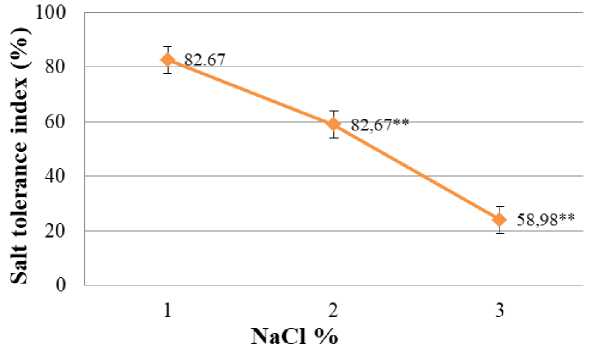
Figure 3. Salt tolerance index of maize plant at different NaCl concentrations
We also investigated the ultrastructure of root in maize plants. Changes in the anatomical structure of the maize plant root under salt stress were studied by light microscopy (Figure 4).
Root cross — section of the control plant contains intact tissues structure. The ultrastructure of the root consists of a well-developed cortex part and core in plants grown under normal conditions. The epidermal tissue consisted of a layer of cells surrounding the inner part of the root in a complete circle form. At the same time, the cortex is surrounded by the epidermis and endoderm from the inside, and there are veins and a layer of phloem in the central part. The cortex was filled with the intact parenchyma tissue. Pith located in the central region of the root has a similar performance of parenchymal cells as in the cortex. The stele consisted of pericycle, phloem, xylem, tissues, and surrounding Pith at the inner part. The salt-treated plant root was different from the control plant as observed by light microscopy (Figure 4). As can be seen from the figure (Figure 4 C, D), we observe the shrinkage of the cortex and core at a 2% concentration of salt, and the disruption of the core at a concentration of 3%.
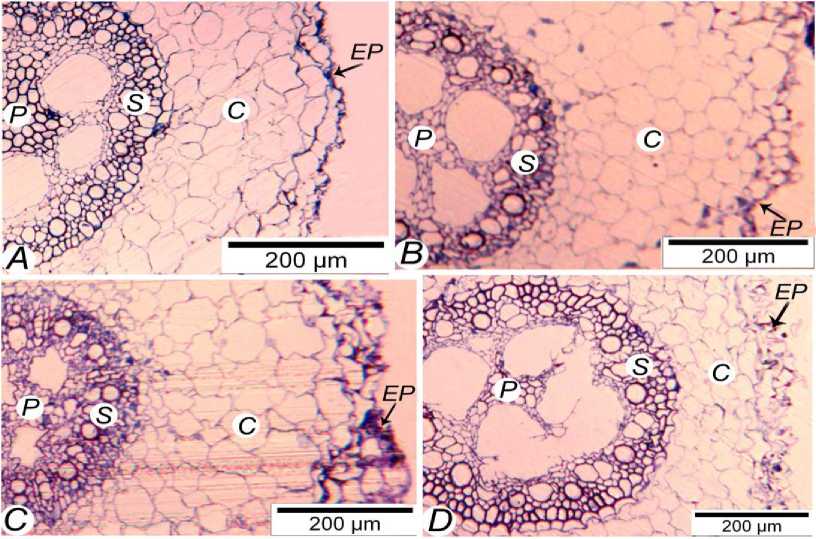
Figure 4. Ultrastructure of bundle sheath (BS) cell chloroplasts in the middle part of the mature second leaf blades in Zea mays after NaCl treatment for 5 days. (A) Chloroplasts of the control (0% NaCl) plant. (B) Chloroplasts of 1% NaCl-treated plant. (C-D) Chloroplasts in the bundle sheath cell of 2% and 3% NaCl -treated plants, respectively, with developed granal stacking; black arrows indicate lipid droplets; white thick arrows indicate granal stacking. Electronograms of ultra-thin sections (50-70 nm). The stains used were uranyl acetate and pure lead citrate
Discussion
Salinity stress is known to be one of the major abiotic stresses that limits plant growth and productivity [1; 4]. Plants grown under increased salt concentration are not able to take up water minerals like K+ and Ca2+ that finally leads to a reduction in growth and inhibition of elongation and cell division [18; 19]. Under salt stress, the suppression of root and plant growth may either be due to osmotic reduction in water availability or to the extreme accumulation of ions, known as the specific ion effect [20]. Similar findings were reported by [10; 22; 23].
The research on seedlings exposed to various NaCl concentrations has confirmed that morpho-physiological parameters (length of root and seedlings, fresh and dry weight of root and seedlings, the area of leaf, root phytotoxicity, salt tolerance index, RWC) of maize plants are sensitive to salt stress. In general, no significant changes were observed in the samples exposed to 1% NaCl. However, high concentrations of salt (2 and 3% NaCl) had a negative effect on almost all growth parameters. Based on the data of the present investigation, due to salinity the root length significantly decreased (Table). This is attributed to reduced water content caused by declined water adsorption under osmotic stress. Konuskan et al. also reported that the root length of different maize genotypes showed significant differences at different salinity levels [24]. Ellouzi et al. reported that reduction in biomass and growth could be due to higher Na+ concentration in the roots and shoots of Arabidopsis thaliana and ionic toxicity and decreased osmotic potential [25]. A decrease in the dry weight of roots and seedlings was noticed also by other authors. The growth parameters and mineral contents-Na, Ca, K, and Cl were investigated in salt-treated and control plants. Results indicated that the NaCl stress markedly reduced the root and plant length, fresh and dry masses. The authors show that Na+ and Cl- contents increased with increasing NaCl concentrations, while Ca2+ and K+ decreased significantly [26; 27].
The present results are in line with findings regarding the reduction of water content due to increasing NaCl salinity. The decrease of relative water content in stressed plants may be associated with the decrease of plant dynamism [26]. Salinity stress showed a strong phytotoxic effect on the root at high salt concentrations. The increased phytotoxicity might be due to the inhibitory or toxic effect of salinity, which is usually observed in the elongation of radicals. Similar findings were reported by Navarro et al. [28] and Kaya et al. [29].
Generally, increasing salinity levels decrease plant growth parameters in the maize plant. It was indicated that the salt tolerance index was a dependable criterion for salinity tolerance in early growth stages of maize [12; 24]. Khatoon et al. defined that maize was more sensitive to salt stress in the germination stage than later growth stages [30]. The highest STI values were shown to correspond to the highest salt tolerance of plants [31]. It is very important to select salt-tolerant genotypes during germination and seedling growth for plant growth and yield [32]. The salt tolerance index decreased significantly, while salinity levels increased as in other investigated characteristics.
It was established that high salinity affects plants in several ways: water stress, ion toxicity, oxidative stress, alterations in the metabolic processes, membrane disorganization, genotoxicity [1; 3]. Together, these effects reduced the growth and development of plants. Our results are in agreement with the reports of other authors revealing a negative relationship between growth parameters and increasing salinity [12].
In our study, we found that the cortex was reduced in stressed roots as compared to control (Figure 4C). Reductions in vascular cylinder and parenchyma were proportional to each other at high salt levels. Changes in shape, size, and thickness of cortical cells were also observed under stress conditions (Figure 4D). We concluded that high salt content affects plant growth by modifying their anatomical traits. Similar changes of the maize plant were shown by Hasan and Miyake [33].
Thus, exposure of maize plants to NaCl stress induces various morphophysiological and ultrastructural changes related to plant growth and development. Reduction in the growth of maize plants under salts stress may result from its effect on ion relations, water status, biochemical reactions, and many physiological factors [34]. The reduction in leaf area of the maize plant under salt stress can be considered as a physiological response, which minimizes water loss when the stomata closed. It is known that the reduction in leaf area in salt-treated plants can be explained by a decrease in leaf turgor and decreased photosynthetic rate [5]. The susceptibility of maize plants to high concentrations of NaCl is demonstrated by growth reduction and loss of fresh and dry mass as shown in our experiments. These effects are probably due to an increase and translocation of Na+ and Cl- ions to the leaf tissue, which causes alterations in the osmotic potential [19].
Conclusion
The research on seedlings exposed to various NaCl concentrations has confirmed that morpho-physiological parameters (length of roots and seedlings, fresh and dry weight of roots and plants, the area of leaves, root phytotoxicity, salt tolerance index, RWC) of maize plants are sensitive to salt stress. Salinity stress showed a strong phytotoxicity effect on the root at high salt concentration. The present results are in line with findings regarding the reduction of water content due to increasing NaCl salinity. The salt tolerance index decreased significantly while salinity levels increased. Based on the obtained results, there is a negative relationship between growth parameters and increasing salinity We conclude that exposure of maize plants to NaCl stress induces various morphological and ultrastructural changes related to plant growth and development.

